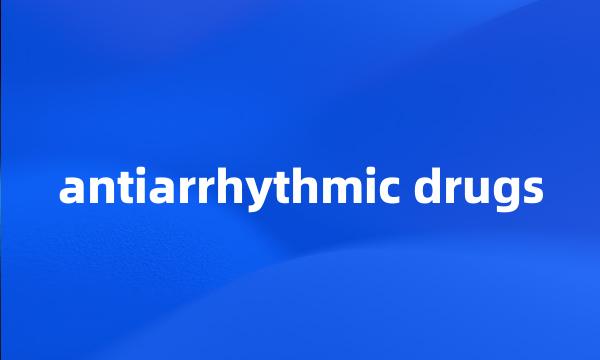antiarrhythmic drugs
- 网络抗心律失常药物;抗心律失常药;抗心率失常药
 antiarrhythmic drugs
antiarrhythmic drugs-
Chinese Market for Antiarrhythmic Drugs : Status and Trends in 2002 ~ 2005
2002~2005年我国抗心律失常药市场状况及趋势分析
-
Metabolism of Antiarrhythmic Drugs and its Affecting Factors
抗心律失常药物体内代谢及其临床影响因素
-
While western antiarrhythmic drugs are almost exist potential arrhythmogenic effect .
但目前西医抗心律失常药物均有潜在的致心律失常作用,在治疗上存在一定的局限性。
-
However , patients with impaired ventricular function also have an increased risk of adverse effects from antiarrhythmic drugs .
然而心室功能受损也使抗心律失常药更易出现毒副作用。
-
Advances in the study of cardiac M_3 receptor as a novel target of antiarrhythmic drugs
心脏M3受体作为抗心律失常药物新靶点研究的进展
-
The Relation of Thyroid Hormone to Ion Channels in Cardiac Myocytes and Development of Antiarrhythmic Drugs
甲状腺素与心肌离子通道关系及抗心律失常药的开发
-
Antiarrhythmic drugs therapy and the risk of recurrence of atrial fibrillation after catheter ablation
心房颤动导管消融术后抗心律失常药物与复发的关系
-
Cardiovascular medicine mainly includes cardiotonic , antiarrhythmic drugs , antihypertensive drugs and antianginal drugs etc.
治疗心血管疾病的药物主要有强心药、抗心律失常药、抗高血压药、抗心绞痛药、降脂药等。
-
Continue to emerge in recent years , new treatments , so that the application of antiarrhythmic drugs is more scientific and reasonable .
近年来不断地涌现出新的治疗手段,使抗心律失常药物的应用更加科学及合理。
-
Radiofrequency ablation vs antiarrhythmic drugs as first-line treatment of symptomatic atrial fibrillation : A randomized trial
比较射频消融与抗心律失常药物作为有症状性房颤一线治疗的随机临床试验
-
Current preventive strategies include the use of beta-blockers and antiarrhythmic drugs such as amiodarone and sotalol .
目前预防的主要措施包括:β受体阻滞剂的及抗心率失常药的使用,如胺碘酮和索他洛尔。
-
Action of k-strophanthin or adoniside with antiarrhythmic drugs on aconitine induced cardiac arrhythmia in mice
毒毛旋花子甙K或冰凉花总甙与抗心律失常药合用于小鼠乌头碱诱发的心律失常
-
Results The incidence of arrhythmia was 24.1 % . Arrhythmia disappeared in all patients after active therapy of etiological correction and proper antiarrhythmic drugs .
结果心律失常发生率为24.1%,经积极纠正病因、恰当抗心律失常药物治疗,心律失常均消失。
-
Based on published papers , this article has reviewed the metabolism of antiarrhythmic drugs , emphasizing on the affecting factors including genetics , sex and drug interaction .
本文综述了抗心律失常药物代谢的研究进展,并详细报道遗传因素、性别因素及药物间相互作用等对抗心律失常药物代谢的影响及其临床意义。
-
As you know , for25 years we have not had any new antiarrhythmic drugs and that was a pity because there was an unmet need .
在过去的25年里,没有新的抗心律失常药物出现,这是个遗憾,因为对此类药物需求很大。
-
This paper carried experiments of 46 cases in 33 dogs to observe the effects of antiarrhythmic drugs on ventricular late potential ( VLP ) in actue myocardial infaction .
本文采用常用抗心律失常药(AAD)对33条犬进行46次实验,观察AAD对实验性急性心肌梗塞(AMI)心室晚电位(VLP)的影响。
-
Eighty-eight per cent of patients receiving antiarrhythmic drugs in the PVI group , and71 % not receiving these agents , were free of atrial fibrillation at6 months .
在肺静脉隔离组,88%的患者服用了抗心律失常药物,没有服用抗心律失常药的患者中的71%,在其后6个月没有发生房颤。
-
After a mean of 10.7 ± 4.9 ( 4 ~ 18 ) months of follow-up , 90.2 % ( 129 / 143 ) cases without antiarrhythmic drugs were free of AF ( including the repeat procedure ) .
术后随访10.7±4.9(4~18)个月,包括第二次消融术后患者在内,共90.2%(129/143)在无抗心律失常药物治疗下无房颤发作。
-
Three patients used antiarrhythmic drugs were not effective for termination , and one patient with hemodynamic deterioration ( shock , pulmonary edema , etc ) wered used synchronized cardioversion ( 100 ~ 150 joules ) converted to sinus rhythm .
3例药物复律无效及1例来诊时伴休克、肺水肿者用100~150J直流电复律,均一次成功转为窦性心律。
-
Till date the antiarrhythmic drugs ( AAD ) including the Class ⅰ and the pure Class ⅲ agents have not been recommended for controlling malignant ventricular arrhythmias in a diseased heart , not because of low efficacy but because of an increase in mortality due to their toxic effects .
当前Ⅰ类及Ⅲ类药均不推荐用于控制室性心律失常,由于药效差及增加死亡率,对病变心脏有毒性。
-
Myocardial gap junction construction and its function modulation in some heart diseases and by antiarrhythmic agents were reviewed , and myocardial gap junction is expected to become another novel target for developing new antiarrhythmic drugs in the new century .
本文阐述了心肌缝隙连接的结构、在疾病中的功能调节及抗心律失常药的作用,展望心肌缝隙连接将成为新世纪开发心血管药物的新靶点。
